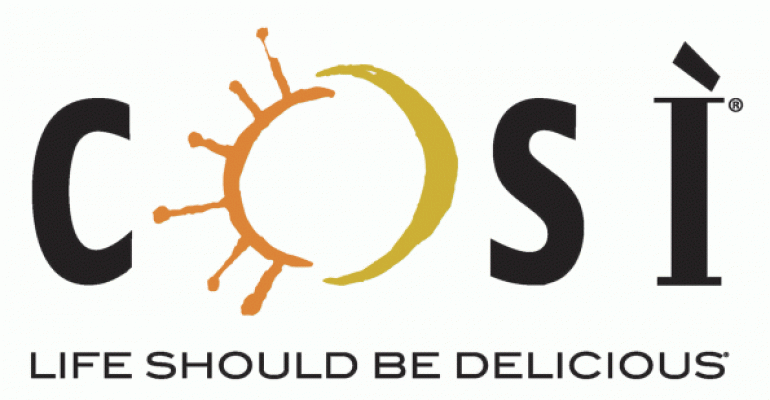Weakening sales over the spring and summer drained Così Inc. of the last of its cash reserves and culminated in this week’s bankruptcy filing and the abrupt closure of nearly a quarter of the chain’s store base.
Court documents filed in the action this week paint a bleak picture of the company’s financial condition and a scramble by board members and management to avoid a full shutdown without seeking debt protection.
A group of the company’s lenders have preliminarily agreed to pay $6.8 million for the chain — minus 29 locations shut down this week — according to filings. The proceeding is expected to move quickly, to enable a sale by late November.
The lenders, which include large Così shareholder Milfam II, would be a “stalking horse bidder” that other prospective buyers would have to outbid during an upcoming auction for the chain.
“I believe there are potential purchasers who will consider bidding against the stalking horse bid,” interim CEO Patrick Bennett wrote in a bankruptcy filing.
The company also asked the court for permission to spend $258,000 to pay bonuses to 125 corporate and store managers deemed “valuable, hard-to-replace employees” so they stay with Così.
Così’s bankruptcy is the result of annual operating losses that date back at least 17 years.
Così was created in 1999, when the 18-unit Così Sandwich Bar merged with the 22-unit Xando Coffee and Bar in a $40 million deal, creating Xando Così. The Xando was ultimately dropped, but by 2003 the rapidly expanding bakery/café chain had 94 locations.
Yet the company’s torrid growth at the time came at the expense of profits. The company has reported annual net losses since at least 1998. Così put itself up for sale in late 2008, when the recession and frozen financing markets prevented any such action.
Così’s strongest year came in 2010, when the company reported a net loss of $3.1 million, on top of $109.7 million in revenues.
The next year, however, the company’s CEO resigned and an investor, former Olive Garden President Brad Blum, offered to take his place at a salary of just $1. Così resisted, ultimately hiring former Brinker International executive Carin Stutz.
Stutz was one of five CEOs to head the chain over 10 years. She was replaced in 2014 by the chain’s largest franchisee, R.J. Dourney, whose Boston-area Hearthstone locations outperformed the rest of the company.
Those locations were merged into the company, yet they didn’t stem the losses.
In 2015, Così started cutting costs and worked to generate positive sales, and for a while seemed to be gaining traction. Same-store sales rose 2.2 percent in the first quarter this year, when Così narrowed its losses. In May, the company said it would generate positive cash flow by the third quarter of this year.
Yet sales had started to fall. Same-store sales fell 0.2 percent in April. And they continued to deteriorate after that. By August, same-store sales fell 10 percent, according to court documents.
Così had $3 million in cash as of June 27.
The sales declines drained most of that in just seven weeks. By the time the bankruptcy was filed, the company had just $950,000 in cash, according to court documents.
Even without the sales decline, Bennett said in his filing the company didn’t think it would be able to repay its debt when it was to come due next April. The company started looking last year at ways to improve the company’s finances, such as refranchising or a refinancing of its debt.
As sales worsened, however, the board began meeting to figure out ways to improve operations. And some board members began talking with investors and bankers to look for a buyer.
All of those firms said the company would not be able to find a buyer, given its financial condition.
In addition to any acquisition cost, a buyer would have to fund as much as $5 million to terminate the leases of 29 underperforming companies, spend $2 million to $30 million to invest in the chain and another $5 million to fund the chain’s losses for the next few months. The buyer would also assume $7.5 million in debt.
Any buyer would spend as much as $20.5 million on the company without considering acquisition costs.
Still, the company has received interest from buyers in the 45 company owned locations not closed as well as the 31 franchisee owned locations, according to the filing.
The stalking horse bid, from Milfam and lenders AB Opportunity Fund LLC and AB Value Partners, L.P., consists of the assumption of $4.1 million in debt, $1.5 million to cure leases and $1.2 million in cash, according to a case summary from Reorg Research.
Meanwhile, Bennett said, the company’s board terminated Dourney based on the company’s finances.
“The board determined, among other things, that the prior CEO’s failure to appreciate the severity of the company’s problems resulted in the company’s failure to address operational issues in a methodical and efficient manner,” Bennett wrote, “and caused extensive waste of effort, time and resources in pursuing transactions with parties who, after conducting their due diligence, were disappointed with the true state of the company’s condition.”
Contact Jonathan Maze at [email protected]
Follow him on Twitter at @jonathanmaze





